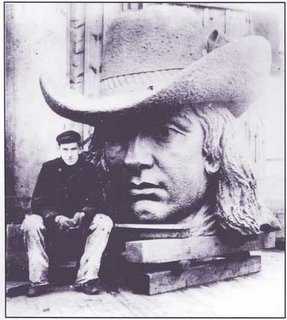Related Topics
Art in Philadelphia
The history of art, particularly painting and sculpture, has been a long and distinguished one. If you add in the art schools, the Philadelphia national influence on artists has been a dominant one.
Quakers: William Penn
Although Ben Franklin gets more ink lately, William Penn deserves at least equal rank among the most remarkable men who ever lived.
Particular Sights to See:Center City
Taxi drivers tell tourists that Center City is a "shining city on a hill". During the Industrial Era, the city almost urbanized out to the county line, and then retreated. Right now, the urban center is surrounded by a semi-deserted ring of former factories.
Tourist Walk in Olde Philadelphia
Colonial Philadelphia can be seen in a hard day's walk, if you stick to the center of town.
Sixth and Walnut over to Broad and Sansom
 In 1751, the Pennsylvania Hospital at 8th and Spruce was 'way out in the country. Now it is in the center of a city, but the area still remains dominated by medical institutions.
In 1751, the Pennsylvania Hospital at 8th and Spruce was 'way out in the country. Now it is in the center of a city, but the area still remains dominated by medical institutions.
Philadelphia's Fourth Century: Revival or Relapse?
Novelists, sociologists, playwrights, financiers, historians, poets -- and others -- have described and explained the rise and fall of Philadelphia. Each of them is a little bit right, and a little wrong. Philadelphia is hidden, but it isn't hiding.
Billy Penn's Hat

|
| Billy Penn's hat |
Philadelphia City Hall was intended to be the tallest building in the world, so there was no reason to suppose anything in Philadelphia would be taller. Gradually, taller buildings in other cities were built, but there grew up a gentleman's agreement that no skyscraper would be built in Philadelphia that was taller than William Penn's hat atop his statue on the tower of City Hall. Planning in the city was organized around this premise, which affects subways and other transportation issues in the city center. Because of assassination fears, a similar tradition in Washington DC was enacted into law, and it must be admitted that the flat skyline of that city looks a little dumb and boring. But Philadelphia neglected to pass a law, and so at the end of the Twentieth Century first one and then half a dozen skyscrapers were built that were twice the height of City Hall, immediately destroying the organizing visual center of the city. Pity.
But there are more serious issues involved. Aesthetics aside, who cares if someone bankrupts himself building an inappropriately tall building, with excessive elevator costs, problems with reinforced foundations, shortage of parking space, and the like? And the answer to that is the new tall building will bankrupt the older office buildings, not itself. Using offers of low, low rents to fill the new building, tenants will be drained from other spaces, and other areas of the city will deteriorate unless there happens to be a general shortage of office space in the region. Carried to an extreme, all of the center city business might be envisioned to reside in one thousand-story building, and the rest of the region would be a desert.
The obvious response would be that no landlord wants to have competition, and new construction is the way a city renews itself, creatively destroying the old to make room for the new. You must not allow the vested landlords to capture the political process with agitation if not bribes. Push things too far in that direction, and you will find that political corruption has destroyed the fabric of the town more effectively than a couple of skyscrapers ever could. Market East has been devastated, it is true. But that's the price of conducting the commerce of the region on the basis of market economics instead of through bureaucracy which masks corrupt politics with high-flown language. Paris is beautiful, but France has 12% unemployment which is closer to 16% if you remember the 30-hour week, the nine-week vacations, and retirement age in the fifties.
And yet, there is certainly a point to be made here. The height limit on new construction must bear some relationship to the regional need for new office space, and not merely rely on beggar-my-neighbor. We're currently hearing about two new projected skyscrapers, one beside 30th Street Station, and the other at 17th and Market/Chestnut. The decision to go or no-go will rest with whether the developers can find "lead" tenants. The corporate officers of these large enterprises are the ones who must be expected to give careful consideration to the best interest of the community because right now they are the ones who control matters. If they neglect their responsibilities, the pressure to pass more zoning laws will prove hard to resist.
Originally published: Monday, June 26, 2006; most-recently modified: Tuesday, May 14, 2019
| Posted by: Katie | Jan 9, 2014 10:37 PM |
| Posted by: Adela | Dec 31, 2012 10:10 PM |